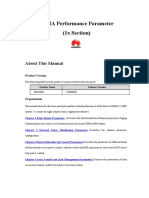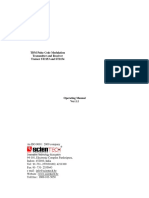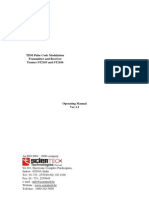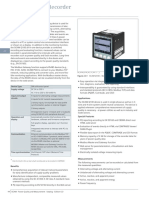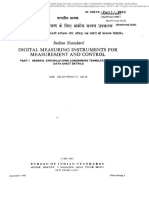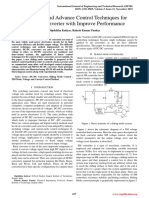WCDMA / HSDPA Signalling Mode: R&S CMU300 Radio Communication Tester For 2G/3G Base Stations
WCDMA / HSDPA Signalling Mode: R&S CMU300 Radio Communication Tester For 2G/3G Base Stations
Uploaded by
Rahul KumarCopyright:
Available Formats
WCDMA / HSDPA Signalling Mode: R&S CMU300 Radio Communication Tester For 2G/3G Base Stations
WCDMA / HSDPA Signalling Mode: R&S CMU300 Radio Communication Tester For 2G/3G Base Stations
Uploaded by
Rahul KumarOriginal Title
Copyright
Available Formats
Share this document
Did you find this document useful?
Is this content inappropriate?
Copyright:
Available Formats
WCDMA / HSDPA Signalling Mode: R&S CMU300 Radio Communication Tester For 2G/3G Base Stations
WCDMA / HSDPA Signalling Mode: R&S CMU300 Radio Communication Tester For 2G/3G Base Stations
Uploaded by
Rahul KumarCopyright:
Available Formats
Product: R&S CMU300
R&S®CMU300
Radio Communication Tester for 2G/3G Base Stations
WCDMA / HSDPA Signalling Mode
Application Note
The R&S CMU300 combines high-precision Node B parameter tests with layer 1 signalling processes for
the first time. Thus, you can now test Node Bs under more realistic conditions as it was possible with
existing concepts. This document describes the new measurement functions and provides an overview of
their applications.
All rights reserved – 1CMP/Gr 10/2005 – 1CM58_E_1.doc Version V2.00
R&S CMU300 3GPP FDD Signalling Mode
Content
1 Introduction.......................................................................................... 2
2 Synchronization and Triggering............................................................ 3
3 BCH Monitoring ................................................................................... 5
4 BER/BLER Tests ................................................................................. 5
5 RACH Test .......................................................................................... 7
6 Realtime HS-SCCH Monitoring ............................................................ 9
7 Realtime HSDPA Throughput Measurement ...................................... 10
8 HSDPA Uplink Generator................................................................... 12
9 HSDPA “Stimulate & Check” Testing ................................................. 13
10 References ........................................................................................ 13
11 Abbreviations..................................................................................... 14
12 Ordering Information.......................................................................... 15
1 Introduction
The increasing use of fast UMTS data services is making the time aspects
of Node B tests more important. Static tests are currently being performed
to find out whether the values of essential Node B transmit parameters
(power, modulation, spectrum, code domain) meet specifications.
However, increasing data throughput rates additionally require that correct
radio channel parameters are also set at the right time. RF parameter tests
are now combined with layer 1 signalling processes within a Node B tester,
i.e. the R&S CMU300, by means of a newly developed WCDMA realtime
receiver.
The Signalling mode, in which the R&S CMU300 synchronizes itself to the
Node B cell channels, offers the following advantages:
• Simplification of the test setup since only RF connections are
required and since previously required Node B trigger interfaces
can now be omitted.
• Availability of the following measurement functions which were
previously not feasible or which required significant technical and
financial efforts:
1CM58_E_1.doc 2 Rohde & Schwarz
R&S CMU300 3GPP FDD Signalling Mode
Ø Time-synchronous TX measurements that can detect
critical moments when switching the radio channel
parameters
Ø An R&S CMU300 trigger output for synchronizing further
measurement instruments (spectrum analyzers, signal
generators)
Ø Analysis of BCH information (SIBs)
Ø BER and BLER analysis of downlink RMCs and data loop
tests
Ø RACH preamble test, including AICH evaluation
Test and measurement solutions for user equipment (UE) and networks
significantly help to ensure that the introduction of HSDPA runs smoothly.
Besides the intensive testing of UE, intensive tests for the introduction of
HSDPA are required in the network itself. Additionally to HSDPA TX
parametric tests the R&S CMU300 allows you to check HSDPA-specific
settings on Node B. Supported applications:
Ø HS-SCCH monitor
Ø HSDPA throughput measurement
Ø HS-DPCCH stimulation on uplink
Ø HSDPA “stimulate & check” procedures
2 Synchronization and Triggering
Before time synchronization can be performed, Node B must first activate
the CPICH and the BCH (mapped on P-CCPCH) cell channels. You have
to know the primary scrambling code and set it manually on the R&S
CMU300. Start synchronization by using the Start Sync key in the
Connection Control menu/Connection tab.
Essential Node B
parameters incl.
running SFN
Indicators for
successfully
completed
synchronization
procedures
By registering the Node B system clock, you can now start transmitter
measurements at specific points in time without additional external
triggering. Thus, you can exactly analyze changes in modulation mode, for
example. You can also synchronously start the UL generator, such as
during BER tests.
1CM58_E_1.doc 3 Rohde & Schwarz
R&S CMU300 3GPP FDD Signalling Mode
3GPP FDD/HSDPA TX measurements of the R&S CMU300:
Power:
• Power meter (wideband or frequency selective)
• CDP
Modulation:
• EVM incl. magnitude/phase error
• Carrier frequency error
• I/Q origin offset
• I/Q imbalance
• Waveform quality
• PCDEP
Spectrum:
• ACLR
• OBW
• SEM
The internal R&S CMU300 start trigger is set via the Connection Control
menu/Trigger tab/Trigger Configuration/Int. Superframe Tr. The Start SFN
parameter determines the beginning of the first measurement, and the
Period parameter determines the repetition period.
Setting of the first
trigger pulse and
repetition period
Configuration of
the trigger output
You can make this trigger accessible to other instruments via the AUX3
front panel connector by setting it by means of the Output Trigger
parameter in the same menu.
1CM58_E_1.doc 4 Rohde & Schwarz
R&S CMU300 3GPP FDD Signalling Mode
3 BCH Monitoring
The BCH monitoring function offers a convenient means of performing
online analysis of the cell system information (SIBs).
Display of all SIBs
received
Display of the
parameters of a
selected SIB (here,
SIB 11)
4 BER/BLER Tests
In the past, bit error ratio (BER) tests were mainly used to characterize the
receive characteristics of the Node B. The realtime receiver in the R&S
CMU300 significantly expands this function by also enabling you to test the
downlink in the same way. In contrast to pure RF parameter
measurements, the entire layer 1 is measured, including the FEC.
These two scenarios are possible:
• Separate measurement of the BTS downlink and uplink. This
requires that the DL data source and UL data analyzer are
provided by the Node B controller. You can use different RMC
types and data contents for the downlink and uplink.
• Simultaneous measurement of both links by using a data loop
(transport layer) in the Node B or in its controller. You have to use
the same RMC type and data content for both links.
R&S CMU300 Node B Node B
Synchronization: Radio (TRX) Controller
Signaling Cell Channels incl.
Receiver P-CCPCH and CPICH
(Demodulator, Transmitter Data Source
FEC, Data Data Analysis of
Analyzer) DL RMC
Trigger Data Loop
RF Generator
Receiver Data Analyzer
incl. Data Source
Stimulation:
UL RMC
1CM58_E_1.doc 5 Rohde & Schwarz
R&S CMU300 3GPP FDD Signalling Mode
Functionality
UL generator: UE simulation
• Supported RMCs: 12.2/64/144/384/2048 kbps
• Data content (transport layer): PRBS 9/11/15/16
• Output level accuracy < 0.6 dB (in the level range -80 dBm to
-125 dBm)
• Optional: AWGN generator function und simulation of bit errors
DL analyzer: DCH evaluation
• Supported RMCs: 12.2/64/144/384/2048 kbps
• Data content (transport layer): PRBS 9/11/15/16
• Single shot measurement with up to 100 000 transport blocks
• Continuous measurement with running averaging via a window of
up to 10 000 transport blocks
• Alternatively, the DL data analyzer can automatically
resynchronize after loss of synchronization. The number of the
synchronizations is counted when this is done. (PN Autoresync.
function).
Measurement Results
DL RMC data
analysis (here,
continuous
measurement with
averaging over
10 000 transport
blocks)
Number of
resynchronizations
in the PN
Autosync. mode
Activation and
level setting of the
UL generator
BER Bit error ratio, ratio of data bit errors to total number of transferred
data bits.
BLER Block error ratio, ratio of blocks received with incorrect data or
CRC bits to total number of received blocks
DBLER Data block error ratio, ratio of blocks received with incorrect data
bits to total number of received blocks
1CM58_E_1.doc 6 Rohde & Schwarz
R&S CMU300 3GPP FDD Signalling Mode
5 RACH Test
The compact tester concept with data generator and data analysis in one
instrument allows you to perform test scenarios that check for correct
Node B responses to UE queries in realtime. Accordingly, the RACH
preamble test of the R&S CMU300 is carried out in accordance with the
ETSI specification 3GPP TS 25.141 FDD, chapter 8.8.1 as follows:
• Start of the transmission of a predefined number of preambles. An
AWGN signal can also be superimposed on these preambles.
• Analysis of the Node B response by means of the AICHs received,
including calculation of the probability of detection of preamble
(Pd) and probability of false detection of preamble (Pfa).
Preamble Configuration
• Fixed scrambling code and level for all preambles to be sent.
• Capability to inject an AWGN signal and directly set a defined
Ec/N0.
• Variable total number of the preambles to be sent: 1 to 224.
• Capability to set the starting time of first preamble to be sent.
• Capability to define a repeating preamble sequence with up to
64 predefined preambles for each sequence.
• Variable access frame number, access slot and signature for
each preamble within the sequence.
Setting of
preamble levels
Total number of
preambles to be
sent
1CM58_E_1.doc 7 Rohde & Schwarz
R&S CMU300 3GPP FDD Signalling Mode
Example AICH Preamble Configuration and timing:
Length of the
repeating
preamble
Setting of the
preamble
sequence
AICH Analysis
Pd: Correct AICHs / number of RACH preambles sent
up to now.
Pfa: Incorrect AICHs / number of access slots analyzed
by Node B up to now.
Correct AICHs: Number of AICHs received with correct signature
and at right time.
Wrong AICHs: Number of AICHs received either at incorrect time
or with incorrect signature.
Detected AICHs: Total number of AICHs received up to now.
Total from Correct & Wrong AICHs.
AICH Average Power: Average AICH power determined from the total of
all current AICH levels / detected AICHs.
1CM58_E_1.doc 8 Rohde & Schwarz
R&S CMU300 3GPP FDD Signalling Mode
6 Realtime HS-SCCH Monitoring
The high-speed shared control channel (HS-SCCH) is important for
communication in HSDPA mode. It transfers information about the nature
of the following data channel (HS-PDSCH) as well as information
indicating which UE the data packet is specified for. The information
applies to the following:
• Channelization code set
• Modulation scheme
• Transport block size
• HARQ process
• Redundancy and constellation
• New data indicator
• UE-ID
Several HS-SCCHs may be transmitted simultaneously. The
R&S CMU300 thus not only monitors the HS-SCCHs but also analyzes
whether the communication in HSDPA mode is taking place correctly.
Node B
Controller
UE1 Transmitter
UE2 Control
Interface
Radio (TRX)
CPICH / BCH
... Synchronization
HS-SCCH
Monitoring
UE128 Receiver
Signaling Receiver
(Demodulator, FEC, Data
Analyzer)
UEs or UE Simulator Node B
Indication of 4xHS-SCCH
Throughput Calculation
R&S CMU300
Setup for HSDPA monitoring and throughput measurements
The R&S CMU300 can simultaneously monitor up to four HS-SCCH
channels. The code channels to be monitored can be selected by the user.
Moreover, the R&S CMU300 can detect up to 128 different UE-IDs. The
UE-IDs to be detected can be determined by means of a list. The
information of the detected HS-SCCHs is displayed directly on the R&S
CMU300’s user interface as follows:
1CM58_E_1.doc 9 Rohde & Schwarz
R&S CMU300 3GPP FDD Signalling Mode
Detail
information
screen of the
selected UE-ID
(here UE-ID 29
at HSFN 19718)
HS-SCCH
monitor with
scheduling
information (here
with three active
HS-SCCHs)
GUI HS-SCCH monitoring
The HS-SCCH information measurement can be performed after
successful CPICH/BCH synchronization in different modes:
Start mode
Start Immediate: Capturing starts right after the user starts the
measurement.
Start at HSFN: Capturing starts when the specified start HSFN is
reached.
Start at UE-ID: Capturing starts when the specified start UE-ID is
detected the first time.
Repetition mode
Single Shot: The measurement is stopped after 1024 HSFNs
are captured (depending on display mode).
Continuous: Continuous capturing of data until the
measurement is explicitly stopped by the user.
Display mode
Result Table vs. HSFN: The monitored HSFNs are displayed continuously.
Result Table vs. UE-ID: Only HSFNs containing data are displayed.
7 Realtime HSDPA Throughput Measurement
The Cell Throughput application measures the HS-PDSCH data rate and
throughput by analyzing the HS-SCCH information. Up to four HS-SCCHs
and 128 different UE-IDs can be monitored and displayed in realtime. The
HS-SCCH channel numbers and UE-IDs to be detected can be determined
by means of lists.For each monitored UE-ID, the current throughput, the
average throughput and the maximum/minimum values are analyzed. By
evaluating the new data indicator flag, data rate and throughput are
differentiated and displayed.
1CM58_E_1.doc 10 Rohde & Schwarz
R&S CMU300 3GPP FDD Signalling Mode
The througput measurement can be performed after successful
CPCIH/BCH synchronization in different modes:
Start mode
Start Immediate: The throughput measurement starts right after you
press the Start button.
Start at HSFN: The measurement starts when the specified Start
HSFN is reached.
Start at UE-ID: The measurement starts when the specified Start
UE-ID is detected for the first time.
Repetition mode
Single Shot: The measurement is stopped after a specific
number of subframes (max. 20479).
Continuous: Continuous capturing of data until the
measurement is explicitly stopped by the user.
Display mode
Current: Data rate and throughput of the current HSFN are
displayed.
Average Average results are calculated over a specified
number of subframes.
Max / Min Max/Min results are recorded over the whole
measurement time.
Bargraph of cell to
be monitored
(blue: data rate;
green: throughput;
red: selected UE-
ID
Detailed
measurement
results including
statistical
evaluation
Selection of a
GUI cell throughput measurement UE-ID
The bargraph shows a rough overview of all UEs to be monitored.
Depending on the display mode, the bargraph shows current, average,
minimum or maximum values. The present display mode is shown in the
upper right corner of the screen. The different colors of the bars show the
data rate and throughput. To show detailed measurement values, a UE-ID
index can be selected. The selected UE-ID iIndex is marked red in the bar
graph and the corresponding UE-ID is displayed. The display mode and
the UE-ID for detailed measurement results can be selected during the
measurement as well as after the measurement is stopped.
1CM58_E_1.doc 11 Rohde & Schwarz
R&S CMU300 3GPP FDD Signalling Mode
8 HSDPA Uplink Generator
The UL generator function simulates one UE and activates an HSDPA
uplink signal in addition to common physical and 3GPP reference
measurement channel types. The high-speed dedicated physical control
channel (HS-DPCCH) can be established with user-defined ACK/NACK
and/or channel quality indicator (CQI) sequences.
Essential features:
• User-definable, continuously repeating sequence of up to 64
ACK/NACK/OFF events
• HSFN- or UE-ID-triggered activation of the ACK/NACK sequence
• User-definable ACK/NACK power ratio
• User-definable number of subframes between two consecutive
ACK/NACKs
• HSFN-triggered activation of the CQI sequence
• User-definable, continuously repeating sequence of up to 64 CQI
events
• User-definable number of subframes between two consecutive CQIs
• User-definable CQI power ratio
Configuration of
ACK/NACK
sequence
Configuration of
CQI sequence
GUI HSDPA uplink generator configuration
1CM58_E_1.doc 12 Rohde & Schwarz
R&S CMU300 3GPP FDD Signalling Mode
9 HSDPA “Stimulate & Check” Testing
The “Stimulate & Check” test of the HSDPA signaling mode is the
combination of synchronous HS-DPCCH stimulation (uplink) and HS-
SCCH monitoring (downlink); the UE signal on the uplink is activated by
the UE-ID trigger derived from HS-SCCH analysis on downlink. Every time
a particular UE-ID is received, an element of the user-defined ACK/NACK
sequence will be transmitted on the uplink. Node B’s reaction on the
downlink can be checked simultaneously using the HS-SCCH monitoring
function, which allows the time-critical behavior of MAC-HS to be tested
dynamically.
Principle of HSDPA “Stimulate & Check” testing
10 References
[1] 3GPP TS 25.141 Technical Specification, 3rd Generation
Partnership Project; Technical Specification Group Radio Access Network;
Base Station (BS) conformance testing (FDD) (Release 5)
1CM58_E_1.doc 13 Rohde & Schwarz
R&S CMU300 3GPP FDD Signalling Mode
11 Abbreviations
ACLR Adjacent Channel Leakage Ratio
AICH Acquisition Indication Channel
BCH Broadcast Channel
BER Bit Error Ratio
BLER Block Error Ratio
CDP Code Domain Power
CPICH Common Pilot Channel
CQI Channel Quality Indicator
DBLER Data Block Error Ratio
DL Downlink
DPCH Dedicated Physical Channel
EVM Error Vector Magnitude
FDD Frequency Division Duplex
HSDPA High Speed Downlink Packet Access
HSFN High Speed System Frame Number
HW Hardware
HS-DPCCH High Speed Dedicated Physical Control Channel
HS-DSCH High Speed Dwonlink Shared Channel
HS-SCCH High Speed Shared Control Channel
Node B WCDMA Base Station
OBW Occupied Bandwidth
PCDEP Peak Code Domain Error Power
Pd Probability of Detection of Preamble
PEP Peak Envelope Power
Pfa Probability of false Detection of Preamble
P-CCPCH Primary Common Control Physical Channel
RACH Random Access Channel
R99 Release 1999
RMC Reference Measurement Channel
RX Receiver
SEM Spectrum Emission Mask
SFN System Frame Number
SIB System Information Block
SW Software
TrCH Transport Channel
TX Transmitter
1CM58_E_1.doc 14 Rohde & Schwarz
R&S CMU300 3GPP FDD Signalling Mode
UL Uplink
12 Ordering Information
TYPE Stock No. Designation
R&S® CMU300 1100.0008.03 UNIVERSAL RADIO COMMUNICATION
TESTER FOR BTS TEST
R&S® CMU-K70 1157.4602.02 SW OPTION FOR CMU300: DTCH BER
ANALYSIS (3GPP/FDD/DL)
R&S® CMU-K71 1157.4702.02 SW OPTION FOR CMU300: RACH
TESTING (3GPP FDD)
R&S® CMU-K72 1200.7603.03 SW OPTION FOR CMU300: HSDPA
STIMULATION, CMU-K78 AND CMU-K72
NECESS.
R&S® CMU-K73 1200.7703.03 SW OPTION FOR CMU300: HS-SCCH
MONITOR and HSDPA THROUGHPUT
MEASUREMENT, CMU-K78 NECESS.
R&S® CMU-K75 1150.3200.02 SW OPTION FOR CMU300:
WCDMA TX TEST (3GPP/FDD/DL)
CMU-U75 NECESSARY
R&S® CMU-K77 1150.4107.02 SW OPTION FOR CMU300: AWGN
GENERATOR AND BER/BLER SIMUL.
(3GPP/FDD/UL) CMU-K76 NECESS.
R&S® CMU-K78 1157.4802.02 SW OPTION FOR CMU300: BCH
SYNCHRONIZATION AND MONITORING
(3GPP FDD)
R&S® CMU-K79 1150.4407.02 SW OPTION FOR CMU300: HSDPA TX
MEASUREMENTS (NON-SIGNALING,
3GPP/FDD/DL), CMU-K75 NECESS.
R&S® CMU-B78 1159.1800.02 HW OPTION FOR CMU300: LAYER1-
BOARD FOR WCDMA DL RX AND UL TX
1CM58_E_1.doc 15 Rohde & Schwarz
R&S CMU300 3GPP FDD Signalling Mode
R&S CMU300 WCDMA Options
Functionality
CMU- CMU- CMU- CMU- CMU- CMU- CMU- CMU- CMU- CMU-
B78 K70 K71 K72 K73 K75 K76 K77 K78 K79
WCDMA / HSDPA TX
√ √
parametric tests
WCDMA
non- Uplink
√ √ ο
signalling generator
mode
BCH
synchronization
√ √
, BCH analysis
and triggering
BER test
includes uplink
generator and √ √ ο √
downlink data
analyzer
WCDMA/ RACH
HSDPA √ √ √
preamble test
signalling HS-SCCH
mode monitor and
HSDPA √ √ √
throughput
measurement
HSDPA uplink
√ √ √ ο √
stimulation
HSDPA
"stimulate & √ √ √ ο √
check"
√ mandatory option
ο extended functionality
History
Version File name Editor Comments
V1.0 1CM58_E.doc R&S Gr CMU300 SW version V3.65 R99 Signaling Mode
V2.0 1CM58_E_1.doc R&S Gr CMU300 SW version V3.82 HSDPA Signaling
Mode added
1CM58_E_1.doc 16 Rohde & Schwarz
R&S CMU300 3GPP FDD Signalling Mode
. . . . .
ROHDE & SCHWARZ GmbH & Co. KG Mühldorfstraße 15 D-81671 München Postfach 80 14 69 D-81614 München Tel
. .
(089) 4129 -0 Fax (089) 4129 - 13777 Internet: http://www.rohde-schwarz.com
This application note may only be used subject to observance of the conditions of use set forth in the download area of the
Rohde & Schwarz website.
1CM58_E_1.doc 17 Rohde & Schwarz
You might also like
- SweetWater Case AnalysisDocument2 pagesSweetWater Case AnalysisSabyasachi Sahu0% (1)
- From GSM to LTE-Advanced Pro and 5G: An Introduction to Mobile Networks and Mobile BroadbandFrom EverandFrom GSM to LTE-Advanced Pro and 5G: An Introduction to Mobile Networks and Mobile BroadbandNo ratings yet
- Pigging Valve Brochure Argus ValvesDocument7 pagesPigging Valve Brochure Argus ValvesIsares PodkohNo ratings yet
- Ericsson Node B & RNC 장비-1CM56 - EDocument16 pagesEricsson Node B & RNC 장비-1CM56 - EHyoung-soo KimNo ratings yet
- 1MA101 0e Fast Scalar Network AnalysisDocument21 pages1MA101 0e Fast Scalar Network AnalysisArturo Della MadalenaNo ratings yet
- Skyworks 01038 ADocument4 pagesSkyworks 01038 AShanu SeherNo ratings yet
- 5G NR (New Radio) X-Series MeasurementDocument20 pages5G NR (New Radio) X-Series MeasurementCharles JenNo ratings yet
- 3G RF OptimizationDocument38 pages3G RF Optimizationfireincitadel100% (1)
- 1CM97 v01 HSUPA CMWDocument62 pages1CM97 v01 HSUPA CMWAllanNo ratings yet
- 1CM95 v1Document60 pages1CM95 v1ciconelNo ratings yet
- A Jitter Injection Signal Generation and ExtractioDocument14 pagesA Jitter Injection Signal Generation and Extractioيبسسي سيسيسيNo ratings yet
- UMTS-RNO-0005 - Drive Test AnalysisDocument30 pagesUMTS-RNO-0005 - Drive Test AnalysiskpreetnarendraNo ratings yet
- 1MA46 0E Transmitter and Receiver Meas Bluetooth ModDocument10 pages1MA46 0E Transmitter and Receiver Meas Bluetooth ModnigelNo ratings yet
- Trilithic_model_Three_Hoja-tecnicaDocument12 pagesTrilithic_model_Three_Hoja-tecnicajose maitaNo ratings yet
- Key Features Platform Highlights: Catv/Satellite/Over-The-Air HDTV Next Generation Test SolutionDocument9 pagesKey Features Platform Highlights: Catv/Satellite/Over-The-Air HDTV Next Generation Test SolutionrsaucedofhsNo ratings yet
- CQI Adjustment Based On DynaDocument10 pagesCQI Adjustment Based On DynaMuhammad JunaidNo ratings yet
- CMA3000 - V-Series - ANRITSUDocument6 pagesCMA3000 - V-Series - ANRITSUNarci EdsonNo ratings yet
- Anritsu CMA3000 Field Tester Data SheetDocument8 pagesAnritsu CMA3000 Field Tester Data SheetJuan Mendez100% (1)
- D Fitzpatrick High Frequency Sampling Technique For Microw.Document5 pagesD Fitzpatrick High Frequency Sampling Technique For Microw.DominicFitzPNo ratings yet
- Testing Applications in Uncompressed HDTV SignalsDocument16 pagesTesting Applications in Uncompressed HDTV Signalswse38No ratings yet
- BSC/RNC Clock Feature Parameter DescriptionDocument21 pagesBSC/RNC Clock Feature Parameter DescriptionSam FicherNo ratings yet
- CMX808A: CML MicrocircuitsDocument24 pagesCMX808A: CML Microcircuitsag1tatorNo ratings yet
- ConnecTIng People EZ430 Chronos WorkshopDocument33 pagesConnecTIng People EZ430 Chronos WorkshopHannes FouldsNo ratings yet
- An 1267Document18 pagesAn 1267Kalash NikovNo ratings yet
- ST2153 & ST2154Document53 pagesST2153 & ST2154Pratap SinghNo ratings yet
- DTMB (CTTB) X-Series Measurement Application N6156A & W6156ADocument14 pagesDTMB (CTTB) X-Series Measurement Application N6156A & W6156AWilliam MakiNo ratings yet
- SENTRON LV10-PH11 Complete English 2014 201405091240417989Document58 pagesSENTRON LV10-PH11 Complete English 2014 201405091240417989rdjkxbjrnoqrgbayzaNo ratings yet
- 5G NR Modulation Analysis (89601BHNC)Document25 pages5G NR Modulation Analysis (89601BHNC)sandeep yadavNo ratings yet
- An Adaptive Pmu Based Fault Detection - Location Technique For Transmission Lines Part IIDocument11 pagesAn Adaptive Pmu Based Fault Detection - Location Technique For Transmission Lines Part IILucas MarinhoNo ratings yet
- CDMA Performance Parameters (1x) V3.0Document326 pagesCDMA Performance Parameters (1x) V3.0ابراهيم معوضةNo ratings yet
- Static and Dynamic Bridge Amplifier Calibration AcDocument5 pagesStatic and Dynamic Bridge Amplifier Calibration AcAndres Camilo Salazar Latorre.No ratings yet
- Infineon-Component Controller Area Network V2.10-Software Module Datasheets-V03 00-EnDocument40 pagesInfineon-Component Controller Area Network V2.10-Software Module Datasheets-V03 00-Ensmitianraj2005No ratings yet
- Hioki - 3535Document8 pagesHioki - 3535Kang IndraNo ratings yet
- 3G Drive TestDocument17 pages3G Drive Testmahado1991No ratings yet
- TDM Pulse Code Modulation Transmitter and Receiver Trainer ST2153 and ST2154 OperatingDocument53 pagesTDM Pulse Code Modulation Transmitter and Receiver Trainer ST2153 and ST2154 OperatingYeshwanth Krishna KolliNo ratings yet
- D05!00!202P FX182 Specification Sheet-1Document5 pagesD05!00!202P FX182 Specification Sheet-1Cabletech CabletechNo ratings yet
- ANSI SCTE 06 2009 Composite Distortion Measurements (CSO & CTB)Document10 pagesANSI SCTE 06 2009 Composite Distortion Measurements (CSO & CTB)Angel AhumadaNo ratings yet
- Sicam PQ100 PDFDocument14 pagesSicam PQ100 PDFsparkCENo ratings yet
- SICAM Q100 - DescriptionDocument14 pagesSICAM Q100 - DescriptionsparkCENo ratings yet
- ST2103 & 2104Document53 pagesST2103 & 2104prdppaliwal67% (3)
- Q100 CatalogDocument14 pagesQ100 CatalogNghĩa DuyNo ratings yet
- PCS-996S-A - PMU - DataSheet - EN - Overseas General - X - R1.00Document37 pagesPCS-996S-A - PMU - DataSheet - EN - Overseas General - X - R1.00mackayaboloaudesteavenNo ratings yet
- Atsc Comisio RohdeDocument33 pagesAtsc Comisio RohdearteagaoNo ratings yet
- ETA SENTRON PAC3100 Power Monitoring DeviceDocument4 pagesETA SENTRON PAC3100 Power Monitoring DeviceDanilloFNo ratings yet
- Fundamental of Time Gated MeasurementDocument4 pagesFundamental of Time Gated MeasurementWan AizuddinNo ratings yet
- CQI Adjustment Based On BLER TargetDocument14 pagesCQI Adjustment Based On BLER TargetBettahar Mohamed100% (1)
- GSM BSC CommandsDocument14 pagesGSM BSC Commandsالمهندس غالبNo ratings yet
- De Embedding and Embedding S Parameter Networks Using A Vector Network AnalyzerDocument24 pagesDe Embedding and Embedding S Parameter Networks Using A Vector Network AnalyzerAlexander LaraNo ratings yet
- NuFlo MC III WPDocument2 pagesNuFlo MC III WPAhmad MarzukiNo ratings yet
- IS-13875-Part 1-1993 (Reaff 2020) (Digital Measuring Instruments For Measuring & Control)Document14 pagesIS-13875-Part 1-1993 (Reaff 2020) (Digital Measuring Instruments For Measuring & Control)Samiran SenNo ratings yet
- Infineon-Component - PSoC - 4 - Timer - Counter - and - PWM - V1.10-Software Module Datasheets-V02 - 01-ENDocument42 pagesInfineon-Component - PSoC - 4 - Timer - Counter - and - PWM - V1.10-Software Module Datasheets-V02 - 01-ENFatenn BellakhdharNo ratings yet
- ISA Certified Control Systems Technician (CCST): Certification Exam Prep: 500 Practice Exam Questions and ExplanationsFrom EverandISA Certified Control Systems Technician (CCST): Certification Exam Prep: 500 Practice Exam Questions and ExplanationsNo ratings yet
- ISA Certified Automation Professional (CAP) Associate: Certification Exam Prep: 500 Practice Exam Questions and ExplanationsFrom EverandISA Certified Automation Professional (CAP) Associate: Certification Exam Prep: 500 Practice Exam Questions and ExplanationsNo ratings yet
- Handbook of Microwave Component Measurements: with Advanced VNA TechniquesFrom EverandHandbook of Microwave Component Measurements: with Advanced VNA TechniquesRating: 4 out of 5 stars4/5 (1)
- UMTS Performance Measurement: A Practical Guide to KPIs for the UTRAN EnvironmentFrom EverandUMTS Performance Measurement: A Practical Guide to KPIs for the UTRAN EnvironmentNo ratings yet
- Reference Guide To Useful Electronic Circuits And Circuit Design Techniques - Part 2From EverandReference Guide To Useful Electronic Circuits And Circuit Design Techniques - Part 2No ratings yet
- Radio Control for Model Ships, Boats and AircraftFrom EverandRadio Control for Model Ships, Boats and AircraftRating: 5 out of 5 stars5/5 (1)
- High-Performance D/A-Converters: Application to Digital TransceiversFrom EverandHigh-Performance D/A-Converters: Application to Digital TransceiversNo ratings yet
- Tutorial 1 Per Unit PDFDocument4 pagesTutorial 1 Per Unit PDFSofia Nadhirah Binti Amluddin100% (1)
- Jun9 - Year 2Document6 pagesJun9 - Year 2isaych33zeNo ratings yet
- Stag-300-6,8 Qmax Basic - Leads Description (2016!03!04) - enDocument1 pageStag-300-6,8 Qmax Basic - Leads Description (2016!03!04) - enIonut Dacian Mihalachi100% (1)
- Ieee Cover LetterDocument4 pagesIeee Cover Letteraflkvapnf100% (1)
- Heat Detector UL CertificateDocument1 pageHeat Detector UL CertificateMd. Biplob HossainNo ratings yet
- Ppe Micro ProjectDocument16 pagesPpe Micro Project2031 Ayush KshirsagarNo ratings yet
- Ghana Tech WorkshopsDocument2 pagesGhana Tech WorkshopsGabrielNo ratings yet
- Modelling and Advance Control Techniques For DC-DC Converter With Improve PerformanceDocument4 pagesModelling and Advance Control Techniques For DC-DC Converter With Improve PerformanceerpublicationNo ratings yet
- Digital TransmissionDocument42 pagesDigital TransmissionChungQuốcNguyễnNo ratings yet
- Shivani 232 PDFDocument17 pagesShivani 232 PDFdigNo ratings yet
- Mechatronics and Control Engineering Course OutlineDocument5 pagesMechatronics and Control Engineering Course OutlineKhDaniNo ratings yet
- Siebel Integration DocumentDocument14 pagesSiebel Integration DocumentChandan Kumar100% (1)
- Código SMD Inductores de PotenciaDocument66 pagesCódigo SMD Inductores de PotenciaDaniela Martinez MNo ratings yet
- NDT Xl-Ut-05.1 Babbit QualityDocument7 pagesNDT Xl-Ut-05.1 Babbit QualityRon KentNo ratings yet
- SOW - Detailed Engineering - Sawan FEC RevampDocument20 pagesSOW - Detailed Engineering - Sawan FEC RevampHafiz Akhtar100% (1)
- Trouble Shooting v3 InterfaceDocument7 pagesTrouble Shooting v3 InterfaceAnthonyNo ratings yet
- Refer Below Table and Answer The QuestionDocument3 pagesRefer Below Table and Answer The QuestionGANDHI BALASUNDARNo ratings yet
- Hitachi Rail Unveils Long-Distance Version of Europe's First Battery TrainDocument3 pagesHitachi Rail Unveils Long-Distance Version of Europe's First Battery TrainDonato ToccoNo ratings yet
- AA139 - LANDING AREA FOR WA HIGH JUMP (8 X 4 X 0.8 M) - enDocument2 pagesAA139 - LANDING AREA FOR WA HIGH JUMP (8 X 4 X 0.8 M) - enmariocapela86No ratings yet
- RAVON BrochureDocument20 pagesRAVON Brochure9868257807No ratings yet
- LiDAR Formulas Wehr LohrDocument15 pagesLiDAR Formulas Wehr LohrbotiwaNo ratings yet
- ENGLISH WRITTEN TEST#1 - RevisedDocument7 pagesENGLISH WRITTEN TEST#1 - Revised오봄No ratings yet
- SP 386089Document2 pagesSP 386089EverardJuanilloNo ratings yet
- Data Communication & Networking Lab ManualDocument53 pagesData Communication & Networking Lab ManualGopalPatel80% (5)
- Vsphere Replication 82 Admin PDFDocument134 pagesVsphere Replication 82 Admin PDFKuldeep KushwahaNo ratings yet
- Modern Myths - Shortcomings in Scientific WritingDocument77 pagesModern Myths - Shortcomings in Scientific WritingLi ChNo ratings yet
- Cooling SystemDocument13 pagesCooling SystemzhiNo ratings yet





























